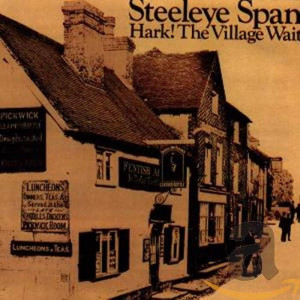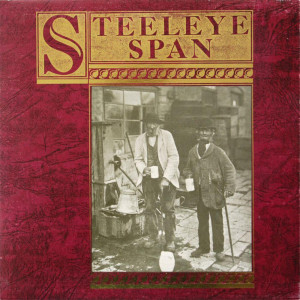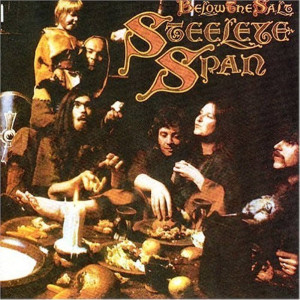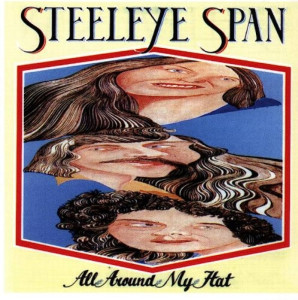Hark The Village Wait (RCA, 1970)
Please To See the King (B&C, 1971)
Ten Man Mop, or Mr Reservoir Butler Rides Again (Pegasus, 1971)
Below the Salt (Chrysalis, 1972)
Parcel of Rogues (Chrysalis, 1973)
Now We Are Six (Chrysalis, 1974)
Commoners Crown (Chrysalis, 1975)
All Around My Hat (Chrysalis, 1975)
Rocket Cottage (Chrysalis, 1976)
Storm Force Ten (Chrysalis, 1977)
Live at Last! (Chrysalis, 1978)
Sails of Silver (Chrysalis, 1980)
On Tour (Australian release) (Chrysalis, 1983)
Back in Line (Flutterby, 1986)
Tempted & Tried (Dover, 1989)
Tonights the Night: Live (Shanachie, 1992)
Time (Shanachie, 1996)
Horkstow Grange (Park Records, 1998)
The Journey (Park Records, 1999)
Bedlam Born (Park Records, 2000)
 When the editor asked me to write a career retrospective about Steeleye Span, it was like someone giving me the keys to his Ferrari with a full tank of petrol and being told to enjoy myself. We are talking here of someone who has been an ardent fan of the band since they started in 1970. Someone who would have given his right leg to have played in Steeleye Span and possibly his left leg to have played in Fairport Convention.
When the editor asked me to write a career retrospective about Steeleye Span, it was like someone giving me the keys to his Ferrari with a full tank of petrol and being told to enjoy myself. We are talking here of someone who has been an ardent fan of the band since they started in 1970. Someone who would have given his right leg to have played in Steeleye Span and possibly his left leg to have played in Fairport Convention.
Where did it all start? I recall back in the late sixties before Steeleye Span there was Fairport making a lot of noise, but even before them was Pentangle, possibly the first real electric folk band. Ashley Hutchings is often credited as being the founder of Steeleye Span, when at the 1969 Keele Festival Tim Hart and Maddy Prior got into conversation with Ashley and other folk musicians over the possibility of electrifying the music they were doing at the time.
Ashley left Fairport with the intention of joining Sweeny’s Men but they disbanded, so he turned to Tim and Maddy to form the basis of Steeleye Span along with Terry and Gay Woods. It was Martin Carthy who suggested the name Steeleye Span – that of a character from the song “Horkstow Grange” – and they were in business. As with all bands, not all members agree on everything all the time; Terry and Gay Woods wanted to call the band Lyubian Waits (a Wait is an old English Village band). Rumour has it that Ashley wanted to call it Middlemarch Wait. I am not sure how they settled on Steeleye Span, but it might account for Ashley Hutchings, Gay and Terry Woods not staying with the band after making the first LP Hark The Village Wait in 1970. Although the album was a huge ground-breaking success, I cannot recall the band ever performing live with this lineup.
 The band’s intention was not to be a rock band, but to be traditional musicians working with electric instruments. This brought them a lot of undue criticism from the self appointed ‘folk police’ who decided what we should hear and what we should or should not like! Thankfully the band took no notice and went on to produce some of the most innovative folk music of the century.
The band’s intention was not to be a rock band, but to be traditional musicians working with electric instruments. This brought them a lot of undue criticism from the self appointed ‘folk police’ who decided what we should hear and what we should or should not like! Thankfully the band took no notice and went on to produce some of the most innovative folk music of the century.
When Gay and Terry Woods left the band Martin Carthy took their place. After they had rehearsed for a couple of months, they realised something extra was needed for the overall sound, and fiddle player Peter Knight was recruited. In 1971 they made two albums with this lineup Please To See The King and Ten Man Mop or Mr Reservoir Butler Rides again. Both of these are excellent albums and were much acclaimed, despite the band still not being signed with a major record label. I remember somebody borrowed my copies and never bothered to return them, always a good sign!
At this point Tim, Maddy and Martin were still working as solo artists as well. This is often a problem; it affects the continuity and creativity of any band and they tend to sound like a group of individuals instead of a band that’s come together. Arguably the first couple of live gigs were not very good, I suspect mainly because of sound engineering problems and inexperience of amplifying acoustic instruments and getting the balance right. This is why nowadays most bands have there own sound engineer on the PA desk; he is really the other member of the band you don’t see. In 1971 when Ashley Hutchings left the band and there was a major policy disagreement between Tim Hart and Martin Carthy. Tim wanted to bring in another bass player and Martin wanted a multi instrumentalist. The result was Martin deciding to leave the band.
To replace Ashley, Rick Kemp was offered the position, and accepting it was probably one of the best decisions he ever made. Rick was virtually unknown on the folk scene. Previously he had worked alongside Michael Chapman, but at the time he was working as a studio session bass player at Sound Techniques Studio, in which Steeleye Span just happened to be recording. In a conversation with a sound engineer, Rick said the only bands he would like to go on the road again with were Free – but Free had broken up – or Steeleye Span. The sound engineer said “well Rick, you are in luck.”
 After doing a few gigs with Maddy and Tim, Peter Knight introduced Bob Johnson to the band and the lineup was almost complete. Bob also came from a pop music background having backed P.J. Proby and Gary Glitter in the past, and was now working as a session musician as well. The influence and experience Rick and Bob brought to the band from playing in bigger venues was to mark a changing point in the band’s sound. Together they recorded the fourth album Below the Salt on Chrysalis in 1972, and with a change of management to Jo Lustig. Steeleye Span had arrived on the big stage. Of all the albums they had made up to this point, Below the Salt was the most entertaining for the wider audience, but still retained that traditional folk feel. Even today, though I have all their albums in my collection (in one format or another), Below the Salt is still the one I play the most.
After doing a few gigs with Maddy and Tim, Peter Knight introduced Bob Johnson to the band and the lineup was almost complete. Bob also came from a pop music background having backed P.J. Proby and Gary Glitter in the past, and was now working as a session musician as well. The influence and experience Rick and Bob brought to the band from playing in bigger venues was to mark a changing point in the band’s sound. Together they recorded the fourth album Below the Salt on Chrysalis in 1972, and with a change of management to Jo Lustig. Steeleye Span had arrived on the big stage. Of all the albums they had made up to this point, Below the Salt was the most entertaining for the wider audience, but still retained that traditional folk feel. Even today, though I have all their albums in my collection (in one format or another), Below the Salt is still the one I play the most.
In early 1973 they recorded the Parcel Of Rogues album. At this point Steeleye left some of their more solemn folk arrangements behind and embarked on a more rock sound. Rick Kemp’s highly imaginative bass line brought the songs to life and pointed the direction they were to go. June 1973 saw the arrival of Nigel Pegram on drums as a full time member of the band. When someone asked him what he was doing before joining Steeleye, he said “basically starving”; he’d had a chequered career playing with assorted bands including Gnidrolog, Halcyon and even The Patrick Samson International Big Band!
The next year, 1974, saw Steeleye Span tour the U.S.A. with Jethro Tull, record the album Now We Are Six, and undertake a marathon three-month tour of U.S.A. and Australia. After this they still found time to return to the U.K. and record the album Commoners Crown that was released in 1975. In late 1974 the management changed from Jo Lustig to Tony Secunda who enlisted Mike Batt as producer for the album All Around My Hat. In the summer of 1975, as every fan knows, the single “All Around My Hat” reached number three in the charts and the album went gold. This was the pinnacle of their career.
 Some people say they went downhill from here on, but I saw it differently. It’s true that the success did go to their heads for a while, but when the dust settled they were back on the road again still producing excellent folk rock music. The rock and roll influence Bob Johnson and Peter Knight brought to the band seemed to have paid off. They recorded Rocket Cottage in Holland 1976. After another tour of U.S.A. and Europe, Peter Knight and Bob Johnson left the band in May 1977 to pursue a separate venture; together they released an album called The King of Elflands Daughter, which met with only a mediocre response, to say the least.
Some people say they went downhill from here on, but I saw it differently. It’s true that the success did go to their heads for a while, but when the dust settled they were back on the road again still producing excellent folk rock music. The rock and roll influence Bob Johnson and Peter Knight brought to the band seemed to have paid off. They recorded Rocket Cottage in Holland 1976. After another tour of U.S.A. and Europe, Peter Knight and Bob Johnson left the band in May 1977 to pursue a separate venture; together they released an album called The King of Elflands Daughter, which met with only a mediocre response, to say the least.
Enter Martin Carthy again in June 1977 on lead guitar. He said his nose told him the time was right for him to join the band again. John Kirkpatrick, another well-known and respected melodeon and concertina player and singer, joined in the same month. With the change of lineup, this meant that Steeleye’s overall sound was to change yet again. This time they would return to their roots, with a more folkie feel to the arrangements. After a short U.K. tour in August, the album Storm Force Ten was released, followed by an extensive European tour. And after a tour of the U.K. in March 1978, the band broke up yet again.
It wasn’t until 1980 that they again re-formed, this time with the return of Bob Johnson and Peter Knight back in the lineup in place of Carthy and Kirkpatrick. A new album Sails of Silver was released in 1980, but this was a slightly different sounding Steeleye Span, partly due to Gus Dudgeon (producer of Elton John and Joan Armatrading) producing the album and all the tracks being contemporary songs, most of them written by the band.
 After Sails of Silver, it seemed that Steeleye Span ceased to be a full time working band. There are many reasons for this in addition to the dismal economics of keeping a full time band on the road. Folk clubs in the eighties in general saw a decline in audience numbers. The band, like most of their fans, had settled down to raise families, and having given up smoking for health reasons, they no longer wanted to sit in a room full of other people’s smoke. With the escalating costs of travel, hotel bills and venues, it was much harder to operate and still have enough money left afterwards to live on.
After Sails of Silver, it seemed that Steeleye Span ceased to be a full time working band. There are many reasons for this in addition to the dismal economics of keeping a full time band on the road. Folk clubs in the eighties in general saw a decline in audience numbers. The band, like most of their fans, had settled down to raise families, and having given up smoking for health reasons, they no longer wanted to sit in a room full of other people’s smoke. With the escalating costs of travel, hotel bills and venues, it was much harder to operate and still have enough money left afterwards to live on.
In the in between years Maddy Prior tried her hand at a solo career and different projects, as did other members of the band. Maddy was the most successful. However, along with many people, I was not overly impressed with her choice of material for her albums and concerts. Unfortunately, the audience who went to see Maddy expected to hear Steeleye songs! Just like actors she was type cast, but if anyone can break the mould Maddy can. We will have to wait and see.
The next eleven years saw various compilation albums released. They sold well and proved there was still a lot of interest in their music. They recorded the Back in Line album in 1986, and Tempted & Tried in 1989. Both lacked the sparkle of the earlier releases and the band was starting to sound tired. In 1992 they recorded Tonight’s The Night – Live, with yet another new lineup. Somewhere along the way Tim Hart quit and seemed to just disappear from the folk scene. I was always a great fan of Tim, ever since I first saw him and Maddy as a duo at my local folk club back in the sixties. Tim had a real folk singer’s voice and an ear for a good song. It is obvious he was a real driving force in choosing the band’s material.
This time the lineup now was Maddy Prior, Bob Johnson, and Peter Knight with the introduction of Liam Genockey on drums and Tim Harries on bass and keyboards. The band now ran on the same formula that most other bands are forced to take – record a new album, then take a short, compact tour. These are usually timed so they can take in the folk festival season. This is not an altogether bad idea, as it leaves at least four to five months of the year free to rest and let their creative juices flow.
The next major album came in 1996 when the long awaited Time album arrived with another change of lineup when Gay Woods returned to the band after 26 years. I don’t think Gay had ever performed with the band other than recording Hark the Village Wait in 1970. At the time in ’96 I wondered if she had been brought in to strengthen Maddy’s singing, or perhaps Maddy wanted to leave the band. Later on that year my suspicions where proved true when Maddy announced she was to leave Steeleye Span.
The band quickly re-grouped with Gay as lead singer. In 1998 the album Horkstow Grange was released to a mixed reaction from the critics. I remember going to see the band on tour and thinking, yes they are good, but this was a different Steeleye Span we where now listening to. Quintessentially Steeleye Span was Tim Hart and Maddy Prior on vocals. They made the band what it was, and without Maddy it is not the same.
Perhaps they should have changed the name of the band when Maddy left, but this was not good commercial sense. The name Steeleye Span sells albums. This was borne out by the release of a special compilation album The Journey in 1999. It was produced from recording made of a special concert on 2 September 1995 in London in aid of the charity called War Child, and all the past and present members of the band got together.
At the turn of the millennium the album Bedlam Born was released with Gay Woods on vocals, Tim Harries bass and keyboard, Peter Knight fiddle, Bob Johnson guitar, and Dave Mattacks on drums. The choice of material on this album meant a marked return to the more rock arrangements of an earlier Steeleye Span lineup. Gay Woods, I am afraid to say, did not fill the lead vocal spot that Maddy left behind, but to be fair to her this is a very big job to take on. I can only think of maybe four or five female vocalists that could do it. I understand that Bob Johnson has now quit the band and Steeleye Span is now defunct.
For over 32 years Steeleye Span in one form or another has made over twenty main albums. Add to this goodness knows how many spinoffs in the form of compilations. Either way their music has been brilliant. Which is their best album? I would have to say Below The Salt from 1972 is my favourite, but each one of the other albums has some excellent songs as well.
I tend to listen to most of my music in the car. I suspect other people do the same. So to enable me to hear everything I want, without the inconvenience plus the danger of fumbling whilst driving and trying to change the tape or CD, I make up my own compilation tapes. From each of the albums I choose what I like the best and put the songs on one tape. So far I have made five different tapes but my all time favourite mix is as follows:
From the album Hark the Village Wait I chose the first track “Calling on Song / The Blacksmith.” This must be the best starter of any album. Also from the same album I chose “The Hills of Greenmore.” From Please to See the King, I chose “The Female Drummer” mainly because the tune used is not the usual one for that song. And from the same album comes “The False Knight on the Road.” From Ten Man Mop I chose “When I was on Horse Back” and “Marrowbones.” From Below The Salt I chose “King Henry” and “The Royal Forester” as they are absolutely brilliant.
From Parcel of Rogues album, I chose “The Bold Poachers” and “Cam Ye O’er Frae France” as they steer up the rebel and Scottish blood in me. From Now We Are Six I chose “Two Magicians” for Rick’s bass line and “Drink Down The Moon” for a tune that never dates. From the Commoners Crown album I take “Long Lankin” because only Maddy can sing this song, and “Galtee Farmer” for the words and arrangement. From All Around My Hat album I chose songs “Black Jack Davy” and “Gamble Gold / Robin Hood.” From the Rocket Cottage album “London Town” and “Fighting for Strangers.”
It had to be “Sweep, Chimney Sweep” and “Seventeen Come Sunday” from the album Storm Force Ten for their tunes alone. From Live at Last I chose “Hunting the Wren” if only for Rick’s bass line in the tune. From Sails of Silver I chose “Marigold / Harvest Home’. From Back in Line I chose “White Man’. From the album Tempted and Tried I chose only the “The Fox” a classic song. From the album Tonight’s the Night I chose “Tamlin” as it is the best version I have ever heard. I chose nothing from Horkstow Grange but from Bedlam Born I chose “The Beggar” – always one of my favourite songs. The song “We Poor Labouring Men” and to finish the selection off I have “John of Ditchford” in a great rock arrangement. I think the older of these songs have stood the test of time and are still good to listen to today alongside the new.
What of the future for Steeleye Span?
I hope there will still be a Steeleye Span in some form or other, as I am sure there is still a big demand for this sort of folk rock. Fairport Convention is still rocking on and seems to fill concert halls wherever they go. I have recently seen the Little Johnny England band perform several gigs. They are probably the latest band of this genre. They make a great sound and are well worth going to see. There were rumours of talks going on at Park Records between Maddy, Rick Kemp, Bob Johnson, Liam Genockey and Peter Knight getting the band back together, but nothing seems settled yet.
If I was management and given the task of putting together a future Steeleye Span. My choice might be:
- John Kirkpatrick for his taste in traditional song and melodeon.
- Nigel Pegrum or Gerry Conway for drums.
- Bob Johnson for his vocals, rock guitar and stability.
- Rick Kemp for bass ingenuity.
- Peter Knight for vocals, and fiddle.
- Janet Russell (Scotland) for her vocal range and strength. (Assuming Maddy does not want the job!)
Whatever the future holds, Steeleye Span has done more for folk music than any other band. It has been a great source of inspiration and entertainment over the years for me and many others. In writing this review I have tried to respect the private lives of the members of the band. They are as the word says, private.
Peter Massey, Chester, UK, September 2002
[Update: Peter Massey’s folk trio the Celtic Notes performed in England, Northern Wales, and Ireland, ran a folk club (the Mucky Duck) in Queensferry, North Wales, and recorded six albums, from 2012 to 2017. They’ve since disbanded due to the pandemic and other health reasons. He still occasionally performs for family and friends via Zoom, “just to keep my guitar in tune!!!”.]

